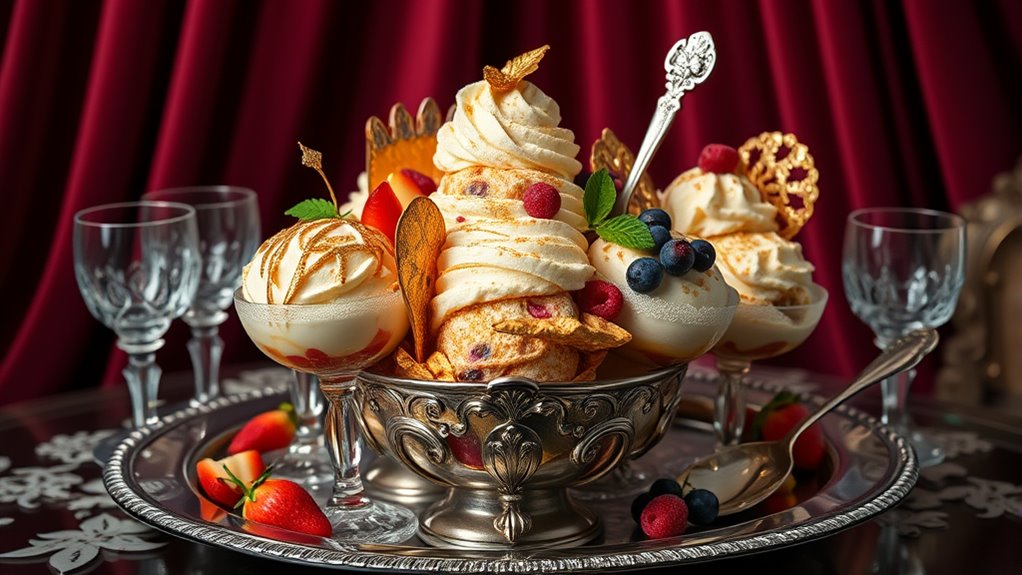Ice cream has long been a symbol of wealth and social status, evolving from exclusive royal court treats to a popular everyday indulgence. In royal courts, serving rare, elaborately crafted flavors showcased power and sophistication. Today, luxury brands continue this legacy by emphasizing high-quality ingredients and elegant presentation to signal exclusivity. If you want to discover how this history shaped modern perceptions of luxury and status, keep exploring how ice cream transformed from aristocratic privilege to a symbol of social distinction.
Key Takeaways
- Historically, ice cream was a luxury enjoyed exclusively by royalty and aristocrats, symbolizing wealth and social power.
- Elaborate presentation and rare ingredients in royal courts reinforced ice cream’s status as a symbol of sophistication.
- Over time, luxury ice cream brands adopted these aristocratic cues to appeal to modern consumers seeking exclusivity.
- The association of ice cream with wealth persisted, transforming from royal displays to premium branding aimed at social distinction.
- Choosing high-end ice cream today continues to serve as a marker of social status, linking contemporary consumption to historical symbols of prestige.

Have you ever wondered why some ice cream brands or flavors carry more prestige than others? It’s not just about taste—it’s about the way certain brands are positioned in the minds of consumers through luxury branding. When you think of high-end ice cream, brands like Haagen-Dazs or artisanal gelato often come to mind, not only because of their rich flavors but because of the status they symbolize. These brands build an image of exclusivity, often using premium ingredients, elegant packaging, and selective distribution channels. That’s no coincidence; it’s a strategic effort to associate their product with a sense of luxury, making it more than just a sweet treat. This approach taps into social hierarchy, where owning or indulging in a certain brand signals a higher social standing. When you choose a luxury ice cream, you’re not just satisfying your sweet tooth—you’re also making a statement about your taste, your lifestyle, and your place within the social fabric.
Throughout history, ice cream has transcended its humble origins to become a symbol of sophistication, especially among the elite. Royal courts in Europe, for example, often featured exclusive ice cream recipes reserved for royalty and aristocrats. Serving elaborate and rare flavors signified wealth and power, reinforcing social hierarchies. The presentation and ingredients used in these early versions of luxury ice cream were carefully curated to showcase abundance and refinement. Over time, this association with prestige persisted, and today’s luxury brands continue to evoke that legacy, offering products that are less about mere consumption and more about status. When you indulge in a premium ice cream, you’re participating in a tradition that links modern luxury to centuries-old displays of wealth and social importance.
Even outside the royal courts, the social hierarchy influences how people perceive and consume ice cream. In many social circles, choosing a high-end brand can elevate your status, while opting for mass-market options might be viewed as less refined. It’s a subtle dance of perception—what you eat and how you present it can impact how others see you. Luxury branding plays a *vital* role here, as it creates an aura of exclusivity and desirability that separates these products from everyday treats. When you purchase or display a premium ice cream, you’re aligning yourself with a certain level of sophistication, reinforcing your place within a social hierarchy that values quality, rarity, and status. In this way, ice cream isn’t just a simple dessert; it becomes a symbol of identity, aspiration, and social positioning.
Frequently Asked Questions
How Did Ice Cream Become Associated With Royalty?
You see, ice cream became associated with royalty through luxury branding and its presence at royal banquets. Nobility and monarchs showcased it as a symbol of wealth, often serving it at grand events to impress guests. Over time, this association elevated ice cream’s status, transforming it from a simple treat into a luxurious indulgence. Your perception of ice cream as a symbol of opulence stems from its historical ties to royal courts.
Which Historical Figures Popularized Ice Cream as a Luxury?
Imagine a royal invitation to indulge in luxury dining—this is how figures like Catherine de’ Medici popularized ice cream as an aristocratic indulgence. She introduced it to France in the 16th century, turning it into a symbol of wealth and sophistication. Later, French kings and European aristocrats continued to elevate ice cream’s status, transforming it from simple dessert to a coveted luxury enjoyed by the elite.
Are There Specific Ingredients That Elevated Ice Cream’s Status?
You’ll notice that using artisan ingredients and luxury additives really elevated ice cream’s status. Chefs and aristocrats added saffron, gold leaf, and exotic spices to create indulgent flavors that symbolized wealth and sophistication. These premium ingredients transformed simple ice cream into a luxurious treat, making it a symbol of opulence. So, it’s not just about cold dairy anymore — it’s about showcasing exclusivity through rare and high-quality ingredients.
How Has the Perception of Ice Cream Changed Over Centuries?
You’ve watched how ice cream’s reputation blossomed from a royal delicacy to a beloved everyday treat. Over centuries, its perception shifted from exclusive luxury to a symbol of joy and comfort. Ice cream marketing transformed it into a cultural icon, capturing hearts across ages. Today, it’s no longer just a dessert but a piece of cultural symbolism—proof that what’s simple can also be extraordinary, echoing through history’s pages.
What Are Some Rare or Exclusive Ice Cream Varieties Historically?
You’ll find that rare or exclusive ice cream varieties often feature luxury flavors and exotic ingredients. Historically, these included saffron, truffle, and gold leaf, reserved for royalty or the wealthy elite. Some chefs even crafted ice creams with rare spices or imported fruits, making them symbols of status and opulence. Today, these luxury flavors still captivate connoisseurs seeking unique, high-end ice cream experiences.
Conclusion
Just as a crown once signified power, ice cream now whispers of your taste and status. It’s the quiet herald of your place in society, a fleeting treasure that elevates the everyday to the extraordinary. Like a secret garden hidden behind a humble gate, its allure lies in what it reveals about you. Ultimately, ice cream remains more than a treat—it’s a symbol of your own story, layered with history, indulgence, and the simple joy of being seen.










